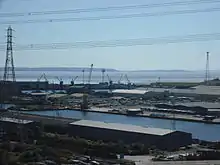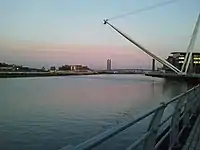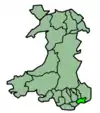Newport Docks
Newport Docks is the collective name for a group of docks in the city of Newport, south-east Wales.
By the eighteenth century there were a number of wharves on the west shore of the River Usk; iron and coal were the principal outward traffic. The considerable tidal range and muddy banks made the wharves inconvenient, and as trade grew, the Town Dock was opened in 1842. It was extended to the north in 1858, and trade increased further.
The Alexandra (Newport) Dock Company was established and a large dock of the same name was opened in 1875, followed by the South Dock in 1893, which was greatly extended in 1907 and 1914. Newport Docks were said to have the largest extent of water in any dock in the world.
The Town Dock has been filled in, but the Alexandra Dock system is still in use, although the vast mineral export traffic has long since ended.
Explosives
The current owners (ABP) future plans for the docks refer to: 4.40 The Port of Newport holds one of the UK’s largest explosives licences for a non-Ministry of Defence port. This has traditionally been important for the Port of Newport and will continue to play a part in the cargo mix, albeit not as a regular form of operational activity.’[1]
A 2004 published navigation guide, ‘Ireland and the West Coast of England’ refers to ‘Explosive Anchorage Areas’ and describes them as being 4 miles south-east from the port entrance and that 48hours notice should be given to the port authorities[2]
In May 2019 the United States Air Force (USAF Europe) moved half a million pounds of net explosives weight from the port to RAF Welford (Berkshire)[3], unloaded from a chartered US ship Ocean Globe at night due to restrictions[4] and the ship's movements.[5]
Minerals

The area at the head of the Newport Valleys, from Tredegar to Pontypool, was rich in minerals: coal and iron, and limestone. The development of iron smelting processes in the eighteenth century led to a massive upsurge in industrial output, and the products of the industry needed to be transported to market. The roads and other communication systems in the eighteenth century were poor, and the minerals were conveyed to a watercourse on the backs of pack animals, at considerable expense. The watercourse closest at hand for the purpose was the River Usk at Newport, and it was to that point that the journey was made. Onward transport by ship from there was relatively easy.
The difficulty and expense of the overland part of the journey resulted in the promotion of the Monmouthshire Canal Navigation. This was authorised by Act of Parliament in 1792 and it was opened in stages from 1796. It extent was from Pontnewynydd, north-west of Pontypool, to Newport, and from Crumlin to Newport. Both arms of the canal were eleven miles long. The canal did not connect into the Usk at Newport, at Crindau, north of the town, and to a basin near Llanarth Street (close to the present-day Charles Street). The Canal Company or the coalowners and ironmasters using it were authorised to make tramroads from any pit within seven or eight miles of the canal, to bring their output to the canalside.[6]
The Monmouthshire Canal Navigation was extremely successful, and it obtained an Amendment Act in 1802, allowing it to make additional wharves on the banks of the River Usk to enable cargoes to be transferred to ships for export. The canal was to be extended a mile and a quarter down the river from Llanarth Street, the original termination, to Pillgwenlly; the cost was said to be £100,000.[7] Work was begun in 1806.[8][9]
Town Dock
The Canal and the associated tramroads were extremely successful, and the industries they supported grew rapidly. The Bristol Channel and its tributary watercourses have a large tidal range, and the wharves on the River Usk were subject to this inconvenience.[10] Promoters in the town put forward a scheme to construct a floating dock, and this was authorised by Parliament by Act of July 1835, with capital of £35,000. After considerable delay, and a massive cost increase, the Town Dock opened on 10 October 1842, having cost £195,000 to build. It covered 4 acres.[11]
Trade continued to grow rapidly, and an extension was planned. Authorised under the Newport Dock Company Act of 1854, it was opened on 2 March 1858; it had cost £64,000 to construct. The original dock became known as the Outer Basin, and the new dock, referred to as the Inner Basin, covered 7 1⁄2 acres.[11][6]
Although at first the loading of the ships with general cargoes was dealt with by the ships' crews themselves, in due course, the Town Dock was equipped with a wide variety of hydraulic handling equipment, and a hydraulic generating power station was provided.
By 1914 the Town Dock was equipped with four coal hoists, three of them being capable of lifting loaded coal wagons of 23 tons gross.
The Town Dock, later known as the Old Dock, was superseded by better equipped facilities, and it was closed in October 1930. It was filled in, and at the present day a shopping complex and bus terminal occupies the site.[11][12]
The Alexandra Dock
The Town Dock was successful, and this success led to a rapid increase in the volume of trade. This required a considerable expansion of the facilities, and it was determined to build new, larger docks at a location nearer the mouth of the Usk. This was authorised by Act of Parliament of 1865 and was known as the Alexandra Dock. During the excavation, the remains of a Viking longship were discovered at a depth of twelve feet below the surface.
The dock opened on 10 April 1875. As soon as the opening ceremony was completed, a telegram was despatched top the Prince of Wales, and shortly a reply was received:
"The Prince of Wales, Sandringhmam, to the Mayor of Newport, Mon. I thank you very much for your telegram, and I congratulate most heartily the inhabitants of Wales on the success of the undertaking."[11]
Company structure: I
Until 1882 there were two dock companies in Newport: the Newport Dock Company, which operated the Town Dock, and the Alexandra (Newport) Dock Company, which operated the Alexandra Dock. By Act of Parliament of 1882, they were amalgamated to form the Alexandra (Newport & South Wales) Docks and Railway Company (ANDR). The Newport Dock Company received £150,000 as the purchase price. The Town Dock was now used for smaller vessels, and in time chiefly for the import trade, especially in timber. Larger cargoes were handled at the Alexandra Dock.
The South Dock
Under an Act of Parliament of 1882, the South Dock was authorised. It opened on 6 June 1893, and covered an area of nearly 20 acres; the former Alexandra Dock was renamed the North Dock. Even while the South Dock was being constructed, the tonnage using the North Dock increased by 750,000 tons. There was a South Lock which enabled larger vessels to enter direct from that end, nearer the Bristol Channel. The South Dock opened on 6 June 1893.[11][6]
It was already obvious that continued growth of business required further accommodation, and work was soon started on the South Dock Extension. This was opened in November 1907, and the Extension was further enlarged by 27 acres, that part opening on 14 July 1914.[11][13] At the date of opening the new lock entrance for the South Dock Extension was 1,000 feet long and 100 feet in width, the largest lock in the world.[6]
Railway sidings
In the nineteenth century and the first decades of the twentieth, the dominant means of land transport was by rail, and the dominant traffic flow was coal for export or coastal shipping. A huge extent of railway sidings was established at Newport to serve the docks; a considerable volume of loaded wagions were held awaiting the availability of a ship for onward transit. By 1908 there were over 100 miles of railway sidings at Newport Docks. In addition there were transit sheds, generally accommodating commodities that required to be stored under cover.[11][13]
The method of loading coal for export in the Alexandra Dock system was by hoists, in which loaded railway wagons are lifted from ground level, in order to tip the contents into the ships' holds. General cargoes were loaded and unloaded by hydraulic cranes, which had capacities from 3 to 30 tons.
Company structure: II
Up until 1922 the docks had been owned by the Alexandra (Newport and South Wales) Dock and Railway Company. Under the Railways Act 1921 most of the railway companies of Great Britain were "grouped" into four large units. The Great Western Railway absorbed a number of smaller concerns within its area of influence, and the Newport Docks passed into its ownership, becoming known as the Great Western Railway's Newport Docks.[11]
Monmouthshire and Brecon Canal
The Monmouthshire and Brecon Canal was originally two independent canals – the Monmouthshire Canal from Newport to Pontymoile Basin (including the Crumlin Arm) and the Brecknock and Abergavenny Canal running from Pontymoile to Brecon. Both canals were abandoned in 1962, but the Brecknock and Abergavenny route and a small section of the Monmouthshire route have been reopened since 1970. Much of the rest of the original Monmouthshire Canal is the subject of a restoration plan, which includes the construction of a new marina at the Newport end of the canal.[14]
References
- "The Port of Newport Masterplan 2015-2035 Consultation Draft" (PDF). bailey.persona-pi.com. Retrieved 12 October 2019.
- Pub142, 2004 Sailing Directions (Enroute): Ireland and the West Coast of England. 2004. ISBN 9781577855569.
- RAF Welford
- "501st Combat Support Wing orchestrates UK's largest munitions supply m". U.S. Air Forces in Europe & Air Forces Africa.
- "OCEAN GLOBE, General Cargo Ship - Details and current position - IMO 9419008 MMSI 367649340 - VesselFinder". www.vesselfinder.com. Retrieved 12 October 2019.
- Newport Docks: The Great South Wales Coal and General Merchandise Port, in the Railway Magazine, September 1918
- The Cambrian (newspaper), 8 June 1805, quoted in Byles.
- Aubrey Byles, The History of the Monmouthshire Railway and Canal Company, Village Publishing, Cwmbran, 1982, ISBN 0 946043 00 0
- Charles Hadfield, The Canals of South Wales and the Border, David and Charles, Newton Abbot, second edition 1967, ISBN 0 7153 4027 1
- Leveson Francis Vernon-Harcourt, Harbours and Docks, Cambridge University Press, 1885 reprinted 2014, ISBN 978 1 108 07202 1
- Jonn Hutton, The Newport Docks and Railway Company, Silver Link Publishing Limited, Peterborough, 1996, ISBN 1 85794 087 3
- "Newport Harbour Commissioners". www.newportharbourcommissioners.org.uk. Retrieved 12 October 2019.
- "Newport Harbour Commissioners". www.newportharbourcommissioners.org.uk. Retrieved 12 October 2019.
- https://canalrivertrust.org.uk/enjoy-the-waterways/canal-and-river-network/monmouthshire-and-brecon-canal


